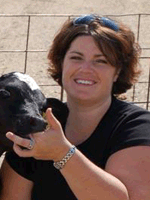
Are Your Calves Feeling the Heat of Summer? – Ann Hoskins
 By Ann Hoskins, Vita Plus calf products coordinator
By Ann Hoskins, Vita Plus calf products coordinator
When heat stress hits on the farm, we often look to the cows first. But did you know that heat stress can hit calves as hard as all the other animals on the farm?
Heat-stressed calves may have reduced average daily gains or increased incidence of treatments. Worst of all, heat stress may cause higher death loss in your calf program.
Calves suffering from heat stress are more likely to become dehydrated and succumb to illness. Signs of heat stress include reduced movement, increased respiration rate, open-mouth panting, decreased milk and starter intake, and increased water consumption.
A calf’s critical temperature range, or thermoneutral zone, is defined as the range in temperature at which the animal performs best. Neil Broadwater, from the University of Minnesota Dairy Extension, says that the optimal thermal environment for a calf is between 55 to 78 degrees F in still air. When the temperature is above or below that, it takes more energy for the calf to perform.
It seems logical to think that calves need more energy in the winter to keep warm, but have you ever considered providing extra energy to calves that are heat stressed? Data from the University of Illinois states that “in times of extreme heat, calves may need an additional 20 to 30 percent more hydration and nutrition.”
Several strategies can help calves survive the heat of summer and water is the first!
Water is always an essential nutrient and is most important for calves living outside their critical temperature range. It is necessary for maintaining body fluids and proper ion balance; for digesting, absorbing, and metabolizing nutrients; for eliminating waste material and excess heat from the body. The amount of water lost from the calf’s body is influenced by air temperature, humidity, respiratory rate, housing conditions and activity of the animal.
Water should be fresh, clean and always available. Care should be taken to ensure adequate water supply during periods of heat stress. When outside temperatures and humidity soar, it is important to add extra water feedings to calves. Change water regularly to prevent algae and bacterial growth and also present it to the calf at a warm temperature (60 to 65 degrees F).
You may want to consider other bedding options to help reduce heat stress in your calf housing. Sand is a great option in summer as long as you have good drainage under the calves. Sawdust or shavings may also work well. No matter what bedding you choose, it needs to be clean and dry.
Keeping flies in check will also help to reduce stress and additional movement. Look at your currently fly control program and make adjustments if necessary. If you are still putting together your fly program for the summer, you can reference “Fly Control Starts Now” in the previous issue of Starting Strong.
Other helpful hints include:
- Open all vents on hutches and pens.
- Use a shade cloth over your hutch pad.
- Move hutches into a tree line or a place out of direct sunlight.
- Raise the rear of the hutch to allow for additional air flow.
- Keep the curtains on barns open, weather permitting.
- Add additional air movement, such as fans, in the calf area (be careful not to draft the calves).
- Reduce stress on the hottest days; avoid dehorning, vaccinations or lots of movement or activity. If you have to do these activities, try to do them in the early morning (the coolest part of the day).
Calves feel the stress of summer just like the rest of us and minimizing that stress will ensure your calves will continue to grow and do well, eventually becoming healthy replacement heifers for the future of your dairy farm.
![]() Talk with your local Vita Plus representative on any questions you may have on heat stress in your calves.
Talk with your local Vita Plus representative on any questions you may have on heat stress in your calves.
| Category: |
Bedding Fly control Heat stress Starting Strong - Calf Care |

